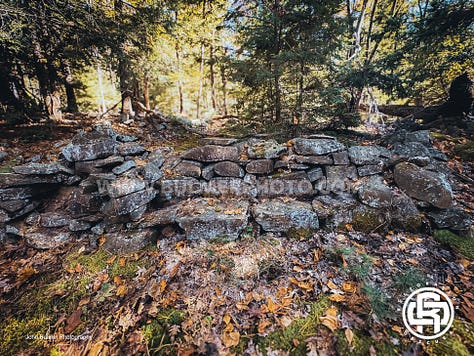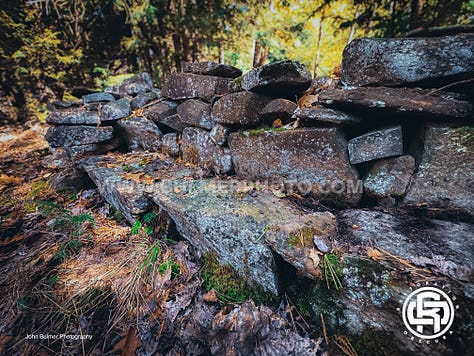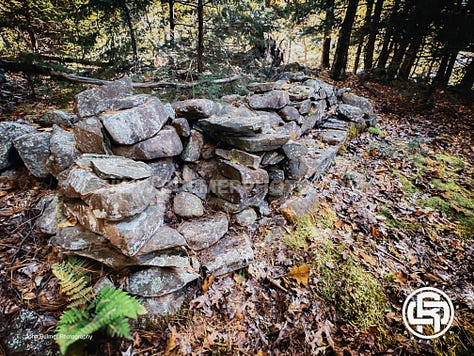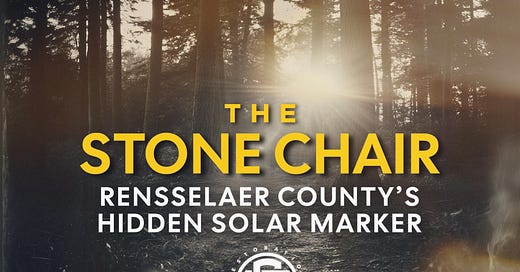Hidden deep in the wooded hills of Rensselaer County lies a stone structure few have seen and even fewer can explain. A carved granite chair, thronelike, precise, and older than memory, sits hidden in a natural bowl, aligned to the sky in ways that suggest it once marked time itself. No trails lead to it. No records name it. Its existence survives through spoken memory, protected by those who understand what silence preserves. Across New England, similar sites hint at a lost system of celestial observation, places where light, stone, and the seasons once worked together to measure the year. This is one of them. A secret solar marker.
Some places never make the map. Others vanish from them entirely—scrubbed by time, neglect, or quiet decision. And then there are the places that were never meant to be found by anyone who wasn’t already looking. The granite chair in the hills of Rensselaer County is one of those: unlisted, unmarked, and remembered only through the careful chain of spoken memory.
At first glance, it seems unremarkable: a large stone seat, shaped with care, set into the natural basin of a forested hill. But look closer and a pattern begins to emerge. The topography has been selected, if not shaped, for visibility and orientation. A throne sits apart from a long bench that could accommodate several people. The arrangement appears deliberate. The alignment, precise. What seems like simplicity may instead be an instrument, a calendar embedded in stone.
Its exact origins are unknown. There are no inscriptions. No formal records. No archaeological surveys to confirm its age or function. Just the site itself, and a spoken history passed carefully between those who still remember. It stands among a broader lineage of ancient observatories, solar markers created for ritual, timekeeping, and survival rather than spectacle or permanence. Across New England and the northeastern woodlands, similar places form a loose network of sky-watching points: cairns, stone circles, standing monoliths, and aligned ridgelines. Many have been misidentified, dismissed, or buried beneath centuries of overgrowth. Together, they reflect a deeper truth: before the land was measured by roads and property lines, it was understood through light and season.
A Forest That Kept Time
Stone markers like this were central to daily life. In cultures shaped by seasonal rhythms, the sun’s position offered guidance. Its movement across the horizon signaled the time to sow, to harvest, to hunt, and to store. These alignments served as practical tools, built into the landscape to track change and prepare for what came next.
The granite chair may have functioned as a fixed point in such a system. It is aligned toward a dip in the horizon, once offering a clear view to sky, though that sightline has since closed with forest growth. Before the tree line advanced, the alignment likely allowed for tracking sunrise points during key solar events. From the throne or the bench, one could have watched the sun rise at specific times of year through natural notches in the landscape, possibly solstices or equinoxes. If accurate, this would suggest a level of observational precision rarely acknowledged in the region’s pre-colonial past.
But the practice itself is not unusual.
From the spiral carvings at Chaco Canyon to the lightbox tombs of Neolithic Ireland, ancient civilizations built observatories that relied on stone, shadow, and seasonal change. Across what is now North America, Indigenous cultures developed complex systems of sky knowledge. The Hopewell of Ohio aligned their massive earthworks to lunar standstills. The Mississippian city of Cahokia constructed a wooden solar observatory, later called “Woodhenge”, where solstices were tracked by the rising sun lining up with carefully placed posts.
In the Northeast, these practices often took less monumental forms: small stone constructs, many of which were attributed to colonial farmers but lack alignment with agricultural or boundary patterns. These structures may have served as viewing points or horizon markers. Settlers often failed to record their presence, either because they didn’t recognize their purpose or because the builders didn’t intend them to be noticed. Sites meant for ceremony or observation can lose their meaning once disturbed.
The Chair
The Rensselaer County structure consists of more than a single seat. A throne-shaped stone sits apart from a long, level bench, positioned for viewing and possibly ceremony. The granite has been smoothed in the seating areas. The throne is slightly elevated, offering a wide view across the bowl-shaped valley below. Behind the bench, a large stone appears deliberately placed to block backlight, enhancing visibility at dawn.
Stone seats like this appear elsewhere in the world, often near solar observatories. In Sardinia, archaeologists have documented granite “priest’s thrones” situated near nuraghe towers—megalithic structures aligned to solstices. In India, the 18th-century Jantar Mantar observatories used carved stone instruments, some seating-based, to track celestial movements with great precision. In Ireland, stone chairs have been found within ceremonial landscapes tied to seasonal transition.
These structures functioned as more than observatories. They served as places where ritual, knowledge, and environment met. To sit in such a place was not passive. It was participatory. The act of watching the sky, year after year, bound people to cycles of time and renewal. It marked transitions not only in the world but in life itself.
A System of Markers
Seasonal solar markers may seem out of place in New England’s forested interior, where thick canopy obscures the sky. But the landscape was different centuries ago. Indigenous firekeeping, rotational agriculture, and temporary settlements created open areas, meadows, ridges, and clearings, more suited to horizon-based observation. These landscapes were dynamic, intentionally managed, and deeply tied to seasonal cycles.
Some of those ancient sightlines still exist. At solstice, shafts of filtered light occasionally slip through narrow breaks in the trees, striking stone edges or momentarily illuminating chambers. To the casual observer, these effects can seem accidental. But many of these alignments reflect deeper patterns. They reveal a worldview in which time was not measured by mechanical clocks, but by the position of the sun at known points on the land.
Glyphs were once present near the chair, according to some accounts, but are now hidden beneath moss or eroded beyond recognition. A few observers claim to have seen faint carvings, symbolic or functional, but none have been verified or documented in detail. Whether these were markings for ceremony, alignment, or memory is still unknown.



What Remains
The Rensselaer site stands out less for its form than for its absence from public record. No plaques mark its presence. No trail signs guide visitors. It has remained untouched by tourism, protected by discretion, and preserved in part through restraint. Its continued survival depends on the decision not to disclose. Too many similar sites have been damaged, through looting, carelessness, or even well-intentioned curiosity. This place survives because those who know it have chosen silence.
This pattern is familiar across the region. Many stone sites in the Northeast have never been recognized by state or federal registries. Pre-colonial stonework in this part of the country often goes unacknowledged, misidentified as boundary walls or farming relics. Entire ceremonial landscapes have been lost under roads and developments—bulldozed without documentation. Yet the work of recognition continues, often outside the academy: through Indigenous scholars, citizen researchers, and caretakers.
Interpretation remains a challenge. Many of these structures are viewed through a colonial lens, seen as practical, utilitarian, or coincidental rather than cultural, spiritual, or astronomical. But a different reading is possible. One that accounts for observation, intention, and continuity.
The Sky Still Turns
Despite centuries of upheaval and dislocation, the sun still reaches the same points in the sky. The solstice still arrives. Light still strikes the same hills. Somewhere in the woods, the granite chair still waits.
Its purpose does not need to be fully known to be respected. The shape, the placement, the alignment, all suggest a relationship with time and place that was deeply understood. Whoever shaped it left more than stone behind. They left a way of seeing.
These markers were instruments of survival. Long before clocks or calendars, people read the sky to shape their days and seasons. The position of the sun was a clock. It told them when to plant, when to harvest, when to follow game, and when to gather close before the freeze.
*Note: Out of respect for the site and the private land on which it resides, the location of the granite chair will not be disclosed. All image metadata associated with this article has been stripped of geolocation information.*¹
Discover Restoration Obscura’s Field Guide to the Night by John Bulmer
A hauntingly beautiful journey through how darkness has shaped human history, culture, and memory, from wartime blackouts and Cold War surveillance to ancient skywatchers and light‑polluted nights. Part memoir, part cultural history, this immersive field guide challenges us to step out of the glow and reconnect with what the night still has to teach.
📚 Paperback ($14.99) / Kindle ($9.99) | 368 pages | Published June 1, 2025 | ISBN 979‑8218702731 | Restoration Obscura Press
Available worldwide on Amazon (Prime eligible)
¹ Images accompanying this article have been altered to remove GPS and EXIF location data. The site is on privately owned land and should not be visited without permission.
Documentation
Aveni, Anthony F. People and the Sky: Our Ancestors and the Cosmos. Thames & Hudson, 2008. A foundational text on ancient skywatching across cultures, with strong sections on Indigenous North American practices.
Basso, Keith H. Wisdom Sits in Places: Landscape and Language Among the Western Apache. University of New Mexico Press, 1996. While focused on the Southwest, this ethnographic work supports the idea of landscape as a living cultural record.
Fowler, Peter J. World Heritage Cultural Landscapes 1992–2002. UNESCO World Heritage Centre, 2003. Details cultural uses of landscape across global traditions, including solar-aligned monuments.
Marshall, James. “America’s Stonehenge: The Mystery Hill Story.” New England Antiquities Research Association Journal, vol. 29, no. 3, 1995. Discusses Northeast stone sites, including alignments and interpretations.
Williamson, Ray A. Living the Sky: The Cosmos of the American Indian. University of Oklahoma Press, 1987. Explores Indigenous sky knowledge across North America, with direct references to solar and lunar tracking.
Further Reading
Curtis, Edward S. The North American Indian (Vols. 1–20). Contains photographs and descriptions of Native astronomical practices and ceremonial landscapes.
Heath, Byron D. America’s Stonehenge Decoded. Self-published, 2005. Explores the controversial “America’s Stonehenge” site in New Hampshire, with attention to alignments and solar use.
Mavor, James W., and Byron E. Dix. Manitou: The Sacred Landscape of New England’s Native Civilization. Inner Traditions, 1989. Essential reading on sacred stone landscapes and alignments in New England, including cairns, chambers, and stone rows.
Ruggles, Clive. Ancient Astronomy: An Encyclopedia of Cosmologies and Myth. ABC-CLIO, 2005. A global reference guide to astronomical practices across cultures, including North American traditions.
Turtle, Louis. Skywatchers of Ancient Mexico. University of Texas Press, 1981.
— While focused on Mesoamerica, this work gives essential comparative context for solar markers and sky-based architecture.
About Restoration Obscura
Restoration Obscura is where overlooked history gets another shot at being seen, heard, and understood. Through long-form storytelling, archival research, and photographic restoration, we recover the forgotten chapters—the ones buried in basements, fading in family albums, or sealed behind locked doors.
The name nods to the camera obscura, an early photographic device that captured light in a darkened chamber. Restoration Obscura flips that idea, pulling stories out of darkness and casting light on what history left behind.
This project uncovers what textbooks miss: Cold War secrets, vanished neighborhoods, wartime experiments, strange ruins, lost towns, and the people tied to them. Each episode, article, or image rebuilds a fractured past and brings it back into focus, one story at a time.
If you believe memory is worth preserving, if you’ve ever felt something standing at the edge of a ruin or holding an old photograph, this space is for you.
Subscribe to support independent, reader-funded storytelling: www.restorationobscura.com
🎧 The Restoration Obscura Field Guide Podcast is streaming now on all major streaming platforms.
Every photo has a story. And every story connects us.
© 2025 John Bulmer Media & Restoration Obscura. All rights reserved. Educational use only.
Permissions Statement
Restoration Obscura may not hold copyright for all images featured in its archives or publications. For uses beyond educational or non-commercial purposes, please contact the institution or original source that provided the image.







